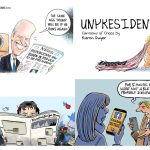In environmental advocacy, where complex issues often require innovative and accessible communication, editorial cartoons are potent tools. These brief, visual commentaries can distill intricate environmental challenges into compelling narratives that resonate with a broad audience. This article explores the symbiotic relationship between editorial cartoons and environmental advocacy, examining how the fusion of humor, art, and commentary can raise awareness and inspire meaningful change.

The Art of Persuasion
Editorial cartoons are a unique medium for communicating environmental issues because they blend humor and satire with insightful commentary. Artists convey messages through visual metaphors, caricatures, and clever wordplay. This fusion of wit and artistry makes complex subjects more digestible and engaging for a diverse audience.
A well-crafted cartoon can speak volumes with just a single image, transcending language barriers and grabbing the attention of even the most apathetic individuals. For instance, a cartoon depicting a melting iceberg shaped like an hourglass conveys the urgency of climate change and the imminent threat to our planet’s future. Such visuals are potent vehicles for raising awareness and fostering a sense of responsibility among viewers.

Humanizing Environmental Issues
One of the strengths of editorial cartoons is their ability to humanize environmental problems. By anthropomorphizing animals, trees, or even inanimate objects, cartoonists create relatable characters that elicit empathy from the audience. This emotional connection is vital for inspiring action, as people are more likely to engage with issues that resonate on a personal level.
Imagine a cartoon featuring a distressed polar bear on a shrinking ice floe, looking at a factory billowing smoke into the atmosphere. This image not only highlights the impact of industrial activities on wildlife but also appeals to our shared sense of responsibility for the well-being of our planet. Through such depictions, editorial cartoons bridge complex environmental challenges and their audience’s everyday lives.

Lampooning Environmental Irresponsibility
Environmental advocacy often involves holding individuals, corporations, and governments accountable for their actions. Editorial cartoons excel in this realm, offering a platform to satirize and criticize unsustainable practices. Cartoonists can provoke thought and encourage viewers to question the status quo by exaggerating the absurdities of environmental negligence.
 For instance, a cartoon portraying a politician riding a wave of plastic waste, oblivious to the environmental repercussions, not only critiques the individual’s indifference but also draws attention to the broader pollution issue. By turning serious subjects into comedic commentary, cartoons have the power to spark conversations and push for positive change.
For instance, a cartoon portraying a politician riding a wave of plastic waste, oblivious to the environmental repercussions, not only critiques the individual’s indifference but also draws attention to the broader pollution issue. By turning serious subjects into comedic commentary, cartoons have the power to spark conversations and push for positive change.

While humor is a potent tool for engagement, it is crucial to strike a balance when addressing severe environmental issues. Cartoons that employ humor should be careful not to undermine the severity of the problems they depict. Striking this delicate balance allows cartoons to capture attention without trivializing the gravity of environmental challenges.
A cartoonist’s skill is transforming serious subjects into compelling visuals without diluting the message’s urgency. Through clever wit and thoughtful satire, these artists create a space for reflection and action, encouraging viewers to confront uncomfortable truths about the state of our planet.

Catalyzing Social and Political Change
Beyond raising awareness, editorial cartoons can influence public opinion and drive policy changes. By presenting environmental issues in a visually engaging and accessible format, cartoons become catalysts for societal dialogue. Viewers are not just passive consumers; they become participants in discussions surrounding climate change, conservation, and sustainable living.
In many cases, cartoons have shaped public perceptions, influenced political decisions, and even mobilized communities. The iconic “Earth Day” cartoon by Walt Kelly featuring Pogo proclaiming, “We have met the enemy, and he is us,” became a rallying cry for the environmental movement in the 1970s. Such instances highlight the transformative potential of editorial cartoons in shaping the narrative around environmental issues.

The Digital Age: Expanding Reach and Impact
The advent of the internet and social media has amplified the reach and impact of editorial cartoons in environmental advocacy. Cartoonists can now share their work globally with just a few clicks, reaching diverse audiences instantaneously. Social media platforms serve as dynamic spaces for the rapid dissemination of cartoons, fostering online communities committed to environmental awareness and activism.
Moreover, the shareability of cartoons enhances their potential to go viral, transcending traditional media boundaries. A well-crafted cartoon can find its way into newsfeeds, sparking conversations among individuals who might not actively seek out environmental content. This democratization of information distribution amplifies the influence of editorial cartoons in shaping public discourse.

Conclusion
In environmental advocacy, where urgency is paramount, editorial cartoons emerge as indispensable tools for communication and change. Their unique blend of humor, artistry, and social commentary captures attention and transforms complex issues into accessible narratives. Editorial cartoons serve as dynamic agents of awareness and activism by humanizing environmental challenges, lampooning irresponsibility, and catalyzing social and political change.
As we navigate an increasingly interconnected world facing unprecedented environmental threats, the power of pen and ink becomes more potent than ever. Editorial cartoons reflect the pulse of our environmental conscience and contribute to shaping a collective vision for a sustainable and harmonious future.
Read also: Exploring Environmental Themes in Children’s Cartoons: A Comprehensive Analysis and Editorial Cartoons and Their Impact on Social Justice Movements
FAQ about the Editorial Cartoons and Environmental Advocacy
Q1: What is an editorial cartoon?
A: An editorial cartoon is a visual commentary that uses humor, satire, and artistic elements to express opinions on current events, political issues, or, in the context of this FAQ, environmental matters. These cartoons distill complex topics into accessible and engaging visuals, often published in newspapers, magazines, or shared on digital platforms.
Q2: How do editorial cartoons contribute to environmental advocacy?
A: Editorial cartoons contribute to environmental advocacy by simplifying complex issues, humanizing environmental challenges, and using humor to engage a broad audience. These cartoons create a visual language that transcends barriers, effectively raising awareness, inspiring action, and influencing public opinion and policy.
A: Humor in editorial cartoons is a powerful tool to engage and educate. By injecting wit and satire, cartoonists can make severe environmental issues more relatable and accessible. Humor captures attention, prompts reflection, and fosters dialogue, which is crucial in promoting environmental awareness and inspiring change.
A: Editorial cartoons have a proven track record of influencing public opinion and catalyzing social and political change. Iconic historical cartoons, such as Walt Kelly’s “We have met the enemy, and he is us,” have become rallying cries for movements. In the digital age, cartoons can quickly reach a global audience, fostering online communities and contributing to a collective call for action.
A: Cartoonists must balance humor and seriousness carefully. While humor is an effective engagement tool, it’s crucial not to trivialize the severity of environmental issues. Skilled cartoonists use wit and satire to bring attention to problems without diluting their gravity, creating a space for reflection and action.
Q6: How has the digital age impacted the reach and impact of editorial cartoons in environmental advocacy?
A: The digital age has significantly expanded the reach and impact of editorial cartoons. Social media platforms allow cartoonists to share their work globally, reaching diverse audiences instantly. The shareability of cartoons enhances their potential to go viral, extending their influence beyond traditional media boundaries and contributing to a broader dissemination of environmental awareness.
Q7: Can cartoons influence policy decisions?
A: Yes, editorial cartoons have the potential to influence policy decisions. By shaping public perceptions and sparking conversations, cartoons contribute to the broader societal discourse on environmental issues. Policymakers, influenced by public opinion, may consider the sentiments expressed in cartoons when formulating or adjusting environmental conservation and sustainability policies.
Q8: Are there any ethical considerations in creating environmental cartoons?
A: Yes, cartoonists must consider the ethical implications of their work. While satire is a powerful tool, it’s essential not to perpetuate harmful stereotypes or misrepresent facts. Cartoons should aim to inform and provoke thought without resorting to offensive content. Responsible and ethical cartooning ensures that the message aligns with the goals of environmental advocacy without causing unnecessary harm.
Q9: How can individuals support environmental advocacy through cartoons?
A: Individuals can support environmental advocacy through cartoons by sharing impactful cartoons on social media, engaging in conversations sparked by these visuals, and actively supporting initiatives that align with the messages portrayed. By being informed and sharing cartoons that resonate with them, individuals contribute to raising awareness and promoting positive environmental change.
Q10: Are there any notable environmental cartoonists or publications to follow?
A: Several cartoonists and publications are renowned for their contributions to environmental cartooning. Some notable names include Patrick Chappatte, Tom Toles, and Joel Pett. Magazines like “The New Yorker” often feature insightful cartoons. Social media platforms are also excellent sources for discovering emerging cartoonists who use their art to advocate for environmental causes.
This post was created with our nice and easy submission form. Create your post!





2 Comments